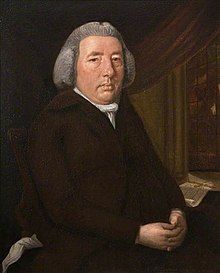Francis Eginton
Francis Eginton | |
|---|---|
 | |
| Born | 1737 |
| Died | 1805 |

Francis Eginton (1737–1805),[1] sometimes spelled Egginton, was an English glass painter.[2] He painted windows for cathedrals, churches, chapels and stately homes, etc., around the country, leaving 50 large works altogether; his work was also exported abroad. His masterpiece is The Conversion of St. Paul, for the east window of St Paul's Church, Birmingham. He also developed a method for reproducing paintings mechanically.
Early life and career
Eginton was the grandson of the rector of Eckington, Worcestershire, and was trained as an enameller at Bilston. As a young man he was employed by Matthew Boulton at the Soho Manufactory. In 1764 Eginton was employed as a decorator of japanned wares, but also did much work in modelling. During the next few years Boulton brought together a number of able artists at Soho, including John Flaxman and James Wyatt; and Eginton rapidly became a skilful worker in almost every department of decorative art.[3]
"Mechanical paintings" or "polygraphs"

Eginton was a partner with Boulton in the production of "mechanical paintings" or "polygraphs" The idea for these was in all probability taken by Boulton from a process modified by
F. P. Smith, then of the
Glass painting
The "picture branch" of Boulton's business was discontinued as unprofitable, the loss on this and the japanning trade being over £500 for 1780. The partnership between Eginton and Boulton was dissolved. Lord Dartmouth proposed to grant Eginton a government pension of £20 a year for his work on the picture copying process, but Boulton raised objections and the offer was withdrawn. For the next year or two Eginton appears to have continued to work at Soho, and to have begun in 1781 to stain and paint upon glass. In 1784 he left Soho and set up in business for himself at Prospect Hill House (demolished in 1871), which stood just opposite Soho.[3][5]
Before Eginton the art of glass-painting had fallen into complete disuse. He revived it and turned out a long series of works in stained glass from his Birmingham factory. His first work of consequence was the arms of the
- Salisbury Cathedral (east and west windows, and ten mosaic windows) and Lichfield Cathedral (east window), after Joshua Reynolds
- The east window of Wanstead Church, Essex
- A large representation of the "Good Samaritan" in the private chapel of the Archbishop of Armagh
- A window in the chapel of the Bishop of Derry's palace
- Memorial and other windows in Babworth Church, Nottingham
- Aston Church, Birmingham
- Shuckburgh Church, Warwickshire
- Tewkesbury Abbey Church
- Lunette above the altar, Catholic chapel, New Wardour Castle, Wiltshire[6]
- The windows of Merton Collegechapel, Oxford
- The ante-chapel of Magdalen College[7]
- The east window at St Paul's Church, Birmingham,[8] where Boulton had a pew.
- The east window at St Alkmund's Church, Shrewsbury.[9]
Eginton painted a window (20 ft. by 10 ft.) representing Solomon and the Queen of Sheba, in the banqueting room of
Eginton's works were, in fact, transparencies on glass. He was obliged to render opaque a large portion of his glass, and thus covered up the characteristic beauty of the old windows. Eginton's showroom was visited by all distinguished visitors to Birmingham.
Personal life
His daughter married Henry Wyatt, the painter; his son, William Raphael Eginton, succeeded to his father's business, and in 1816 was appointed glass-stainer to Princess Charlotte. His brother, John Eginton, was a noted stipple engraver. His nephew, also called Francis Eginton, was also a notable engraver.[3]
Eginton died on 26 March 1805, and was buried in Old Handsworth churchyard.[3]
References
- ^ "Francis Eginton". Birmingham Museums and Art Gallery.
- ^ Harries, John; Hicks, Carola (2008). Discovering Stained Glass. Osprey Publishing. p. 73.
- ^ a b c d e f g h i "Eginton, Francis (1737-1805)". Dictionary of National Biography. London: Smith, Elder & Co. 1885–1900.
- ^ George Wallis. The Ghost of an art-process (The Art Journal, volume 5, pub. Vertue, 1866) pp. 251-5.
- ^ Prospect Hill House (engraving of Eginton's residence - "Staffordshire fast Track")
- ^ Historic England. "Wardour Castle Chapel (1300093)". National Heritage List for England. Retrieved 25 June 2020.
- ^ L. F. W. Jewitt. The Wedgwoods etc. (London, Virtue Brothers, 1865) p. 354.
- ^ St Paul's website - Features of St Paul's Church Archived 15 November 2012 at the Wayback Machine
- ^ St Alkmunds Church From Shropshire Tourism website.
- This article incorporates text from the article "Eginton, Francis" in A biographical history of the fine arts by Shearjashub Spooner, an 1873 publication now in the public domain.
External links
- St Alkmunds Church (East window by Eginton)
